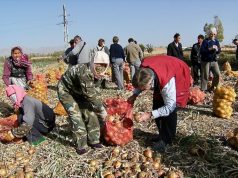This is Part 2 of a book on NZCFS involvement in poverty alleviation in NW and Central China through aid in the development of co-operatives in those regions. For an Introduction and Part 1, click HERE.
Part 2
Detailed case studies are presented of 12 of the 50 co-operatives assisted by NZCFS. It sets out in informative detail the many trials and significant successes that the Chinese encountered in their goal of creating co-ops.
So, we have selected, as a taster, three of the co-operatives covered in the book and we summarise their development, both present and past, and something about the people who initiated them. Their connections to NZCFS are also explained. For the rest, we recommend you read the book.
Qianyang Xinxing Handicrafts Co-operative

Qiayang Xixing Co-operative is located 230km from Xi’an, in Shaanxi Province. Traditional handicrafts in this area include embroidered wall-hangings, shoes and clothes, paper-cuttings, masks, clay figurines and many more. The County government supported the development of handicrafts providing financial assistance and by the end of 2013, 14 handicraft co-ops had been established.
Later in 2011, the NZCFS set up a project in partnership with the Shaanxi Women’s Federation to provide training for women’s co-ops in Baoji. The Baoji Women’s Federation nominated Xinxing Co-op which was provided with training not only in management but also in technical skills for handicraft production.
The story of the Qianyang Xinxing Co-operative, is followed by the story of co-op initiator, Yang Linzhuan. This gives an insight into the hardships experienced by, and the determination of a very hard-working lady to overcome them.
Golden Qinchuan Kiwifruit Co-operative

In the 1980s, Meixian County proved to be an ideal place for Kiwifruit cultivation after a survey had found that wild kiwifruit in the area could be domesticated and improved.
This section of the book explains the development of kiwifruit culture in the area culminating in 2004 in the collaboration with a kiwi-fruit Chinese company, Global Horticulture (Xi’an) Ltd. This work was so successful that by 2013 kiwifruit were being grown in 123 villages with 60,000 families, each working their own 4.1 mu plots, representing 80% of the county’s cultivated land. In 2012, the kiwifruit harvest was 350,000 tones, a tremendous success and a fascinating story to read, describing as it does the many obstacles overcome, and innovations needed to improve production and quality.
Another fascinating life story is told of the mainstay of the co-op, Bai Mei, and the hardships she endured – another insight into the lengths that a hard-working Chinese woman will endure to provide a decent life for her family and community.
In 2011, the Golden Qinchuan Kiwifruit co-op was also selected to take part in the NZCFS-supported ‘Women’s Co-op Development Project’. This helped to identify strengths and weaknesses of the co-operative in areas such as strategic planning, co-op governance, increasing member participation, business and financial management.
Xinba Nuanquan Red Grape Co-operative

Xinba township is in Gaotai County in Gansu Province, much of which is alluvial flood plain, but normally is very dry. In the annual frost-free period of 120 days, the township at the foot of the mountains takes advantage of the warm weather to develop grapes in greenhouses. 1738 greenhouses were built, allowing the grapes to mature in November/December and ready for the high-value consumer market at Spring Festival in January/February.
Sheng Zuoxin is the founder of the co-op and there is a description of his work in founding the co-op.
In 2008, the Red Grape Co-op leader took part in a training session held by Bailie School in Shandan. As a result, he invited the instructor to visit their village to talk to the villagers about co-ops, and eventually, in 2009, the Nuanquan Village Red Grape Growers Co-op was registered with the Central Government – an essential and crucial step.
The above are just three of the 12 co-ops described in Liu Guozhong and Tim Zachernuk’s book. Nine more which are described in interesting detail.
Reading these reports, one cannot fail to admire the determination of the rural Chinese people to improve their lives and their willingness to work so hard in the process. The reports are very informative as well as being well written. They make recommended reading for all who are interested in modern Chinese co-operatives.
Part 3 of the book deals with the admission that co-ops are still in their development stages and goes on to give detailed information on how to set up a new co-op, the part NZCFS has played in the co-ops (50 to date) and an explanation of the institutional structure of the government in China. The information will be compulsive reading for any small communities considering starting a new co-op.
For a pdf of the complete second part of the book, click HERE
For a pdf of the complete Part 1, click HERE
Teri France




